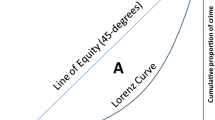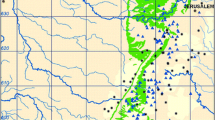Abstract
In this paper, a new nonmetric method called POSAC is presented and illustrated through an analysis of the crime patterns of all the states in the United States. POSAC is a graphical technique for the display of multivariate data in a two-dimensional space. It maps the rows (e.g., states) of a matrix in a way that maximizes the preservation of theirpartial order, with similar states located in close proximity on the map. POSAC is based on the partial order among observations rather than their actual magnitude. POSAC seems to bear the same relationship to the principal-component analysis (PCA) as that borne by the median to the arithmetic mean. As a matter of fact, POSAC is a form of ordinal factor analysis. Its advantage over PCA is its robustness to the data. The technique enables observations and variables to be studied simultaneously. Seven index crime categories are analyzed. In order to demonstrate the utility of POSAC in detecting changes in crime patterns over time, we included in our analysis three selected years: 1944, 1965, and 1987. The results for the year 1987 are compared to those obtained by PCA.
Similar content being viewed by others
References
Archer, D., and Gartner, R. (1981). Homicide in 110 nations. In Shelley, C. (ed.),Readings in Comparative Criminology, Southern Illinois University Press, Carbondale, pp. 78–99.
Brantingham, P., and Brantingham, P. (1984).Patterns in Crime, Macmillan, New York.
Canter, D. (1985).Facet Theory Approaches to Social Research, SSSP, Springer-Verlag, New York.
Du Toit, S. H. C., Steyn, A. G. W., and Stumpf, R. H. (1986).Graphical Exploratory Data Analysis, Springer-Verlag, New York.
Guttman, L. (1950). The basis for scalogram analysis. In Stauffer, S. A.,et al. (eds.),Measurement and Prediction, Vol. 4, Princeton University Press, Princeton, NJ.
Harries, K. D. (1971). The geography of American crime.J. Geography 70: 204–213.
Harries, K. D. (1976). Cities and crime: A geographical model.Criminology 14: 369–386.
Humphrey, J. A., and Kupferer, H. J. (1977). Pockets of violence: An exploration of homicide and suicide.Dis. Nerv. Syst. 38: 833–837.
Jollife, I. T. (1986).Principal Component Analysis, Springer-Verlag, New York.
Kowalski, G. S., Dittman, R. L., Jr., Bung, W. L. (1980). Spatial distribution of criminal offenses.J. Res. Crime Delinq. 17: 4–25.
Land, K. C., McCall, P. L., and Cohen, L. E. (1991). Characteristics of U.S. cities with extreme (high or low) crime rates: Results of discriminant analyses of 1960, 1970, and 1980 data.Soc. Indicat. Res. 24: 209–231.
Landau, S. F. (1984). Trends in violence and aggression: A cross-cultural analysis.Int. J. Comp. Sociol. 25: 133–158.
Linsky, A. S., and Straus, M. A. (1986).Social Stress in the United States, Auburn House, Dover, MA.
Lottier, S. (1938). The distribution of criminal offenses in sectional regions.J. Crim. Law Criminal. Police Sci. 29: 329–344.
Messner, S. F. (1982). Social development, social equality and homicide: A cross-national test of a Durkheian model.Soc. Forces 61: 225–240.
Raveh, A. (1986). On measures of monotone association.Am. Stat. 40: 117–123.
Schuessler, K. (1962). Components of variation in U.S. city crime.Soc. Problems 9: 314–321.
Shannon, L. W. (1954). The spatial distribution of criminal offenses by states.J. Crim. Law Criminol. Police Sci. 45: 264–273.
Shye, S., and Amar, R. (1985). Partial-order scalogram analysis by base coordinates and lattice mapping of the items by their scalogram roles. In Cantor, D. (ed.),Facet Theory Approaches to Social Research, Springer-Verlag, New York, pp. 277–298.
Shye, S., and Elizur, D. (1976). Worries about deprivation of job rewards following computerization: A partial order scalogram analysis.Hum. Relat. 29: 63–71.
Smith, D. I., and Burvill, P. W. (1987). Effect on juvenile crime of lowering the drinking age in three Australian states.Br. J. Addict. 82: 181–188.
Spector, P. (1975). Population density and unemployment: The effects on the incidence of violent crime in the American city.Criminology 12: 399–401.
Statistical Abstracts of the United States (1944, 1965, 1987).
United Nations (1977).Crime Prevention and Control: Report to the Secretary General, A/32/150, Sept. 22, United Nations, New York.
Yalan, E., Finkel, C., Guttman, L., and Jacobson, C. (1972).The Modernization of Traditional Agricultural Villages: Minority Villages in Israel, Settlement Research Center, Rehovot, Israel.
Author information
Authors and Affiliations
Rights and permissions
About this article
Cite this article
Raveh, A., Landau, S.F. Partial order scalogram analysis with base coordinates (POSAC): Its application to crime patterns in all the states in the United States. J Quant Criminol 9, 83–99 (1993). https://doi.org/10.1007/BF01064238
Issue Date:
DOI: https://doi.org/10.1007/BF01064238




